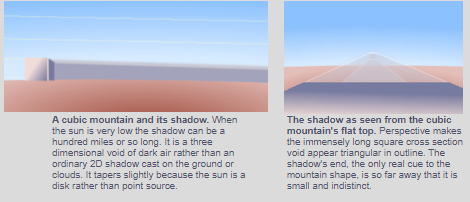Mountain shadow formation
Mountain Shadow Formation: A Fascinating Phenomenon
Mountain shadow formation is a captivating atmospheric optics phenomenon that occurs when the sun is very low in the sky. Unlike ordinary 2D shadows cast on the ground or clouds, mountain shadows are three-dimensional voids of dark air. These immense shadows can stretch for hundreds of miles, creating a mesmerizing spectacle for observers. In this article, we will delve into the intricacies of mountain shadow formation and explore the factors that contribute to their unique characteristics.
When the sun is low on the horizon, a cubic mountain casts an elongated shadow that can span over a hundred miles. The tapering effect of the shadow occurs because the sun is not a point source, but rather a disk. This three-dimensional void of dark air is a remarkable sight to behold, defying our expectations of traditional shadows.
From the vantage point of the cubic mountain's flat top, perspective plays a significant role in shaping our perception of the shadow. Due to this perspective effect, the immensely long square cross-section void appears triangular in outline. As we stand at the top edge of the shadow tunnel and gaze along its length, we are immersed in the grandeur of this natural phenomenon.
During sunrise and sunset, mountain shadows take on an ethereal quality, resembling long tunnels of unlit air. These shadows, known as crepuscular rays, add to the mystique and beauty of the scene. As the sun's rays interact with the atmosphere and cast these immense shadows, observers are treated to a visual spectacle that is both awe-inspiring and humbling.
Interestingly, regardless of the mountain's profile, perspective effects almost always render the shadow as a triangular shape when viewed from the summit. This intriguing phenomenon occurs because we are positioned at the top edge of the shadow tunnel, looking out along its vast length. However, it is important to note that only the shadow's end provides substantial information about the mountain's shape. Unfortunately, due to its distance and the slight blurring caused by the 0.5º angular spread of the sun's rays, the shadow's end is often small and indistinct.
Mountain shadow formation is a captivating subject that continues to intrigue scientists and enthusiasts alike. By studying these shadows, we gain valuable insights into the behavior of light and the intricate interplay between the sun, mountains, and the atmosphere. The following are some key points to consider when exploring this fascinating phenomenon:
- Mountain shadows are three-dimensional voids of dark air, rather than ordinary 2D shadows.
- The length of mountain shadows can span over a hundred miles when the sun is very low in the sky.
- Perspective effects make mountain shadows appear triangular when viewed from the summit.
- Crepuscular rays, observed during sunrise and sunset, add to the enchantment of mountain shadows.
- The sun's disk shape causes the tapering effect of mountain shadows.
- Only the shadow's end provides substantial cues about the mountain's shape.
- The 0.5º angular spread of the sun's rays can blur the shadow's end, making it difficult to discern details.
- Mountain shadow formation offers valuable insights into the behavior of light and atmospheric optics.
- Scientists and enthusiasts continue to study mountain shadow formation to deepen our understanding of this captivating phenomenon.
In conclusion, mountain shadow formation is a captivating atmospheric optics phenomenon that mesmerizes observers with its immense length and unique characteristics. By exploring these shadows and unraveling their secrets, we gain a deeper appreciation for the interplay between light, mountains, and the atmosphere. The awe-inspiring beauty of mountain shadows serves as a reminder of the wonders that surround us in nature.

A cubic mountain and its shadow. When the sun is very low the shadow can be a hundred miles or so long. It is a three dimensional void of dark air rather than an ordinary 2D shadow cast on the ground or clouds. It tapers slightly because the sun is a disk rather than point source.
The shadow as seen from the cubic mountain's flat top. Perpective makes the immensely long square cross section void appear triangular in outline. the shadow's end, the only real cue to the mountain shape., is so far away that it is small and indistinct.
Mountain shadows at sunrise and sunset are immensely long tunnels of unlit air, crepuscular rays in fact.
From the summit, perspective effects nearly always make the shadow triangular regardless of the mountain's profile. You are standing at the top edge of the shadow tunnel and looking out along its length which can be more than a hundred miles. Only the shadow's end carries much information about the mountain shape and it is so far away and in any event blurred by the 0.5º angular spread of the sun's rays that it is hardly visible.
Note: this article has been automatically converted from the old site and may not appear as intended. You can find the original article here.
Reference Atmospheric Optics
If you use any of the definitions, information, or data presented on Atmospheric Optics, please copy the link or reference below to properly credit us as the reference source. Thank you!
-
<a href="https://atoptics.co.uk/blog/mountain-shadow-formation/">Mountain shadow formation</a>
-
"Mountain shadow formation". Atmospheric Optics. Accessed on December 22, 2024. https://atoptics.co.uk/blog/mountain-shadow-formation/.
-
"Mountain shadow formation". Atmospheric Optics, https://atoptics.co.uk/blog/mountain-shadow-formation/. Accessed 22 December, 2024
-
Mountain shadow formation. Atmospheric Optics. Retrieved from https://atoptics.co.uk/blog/mountain-shadow-formation/.